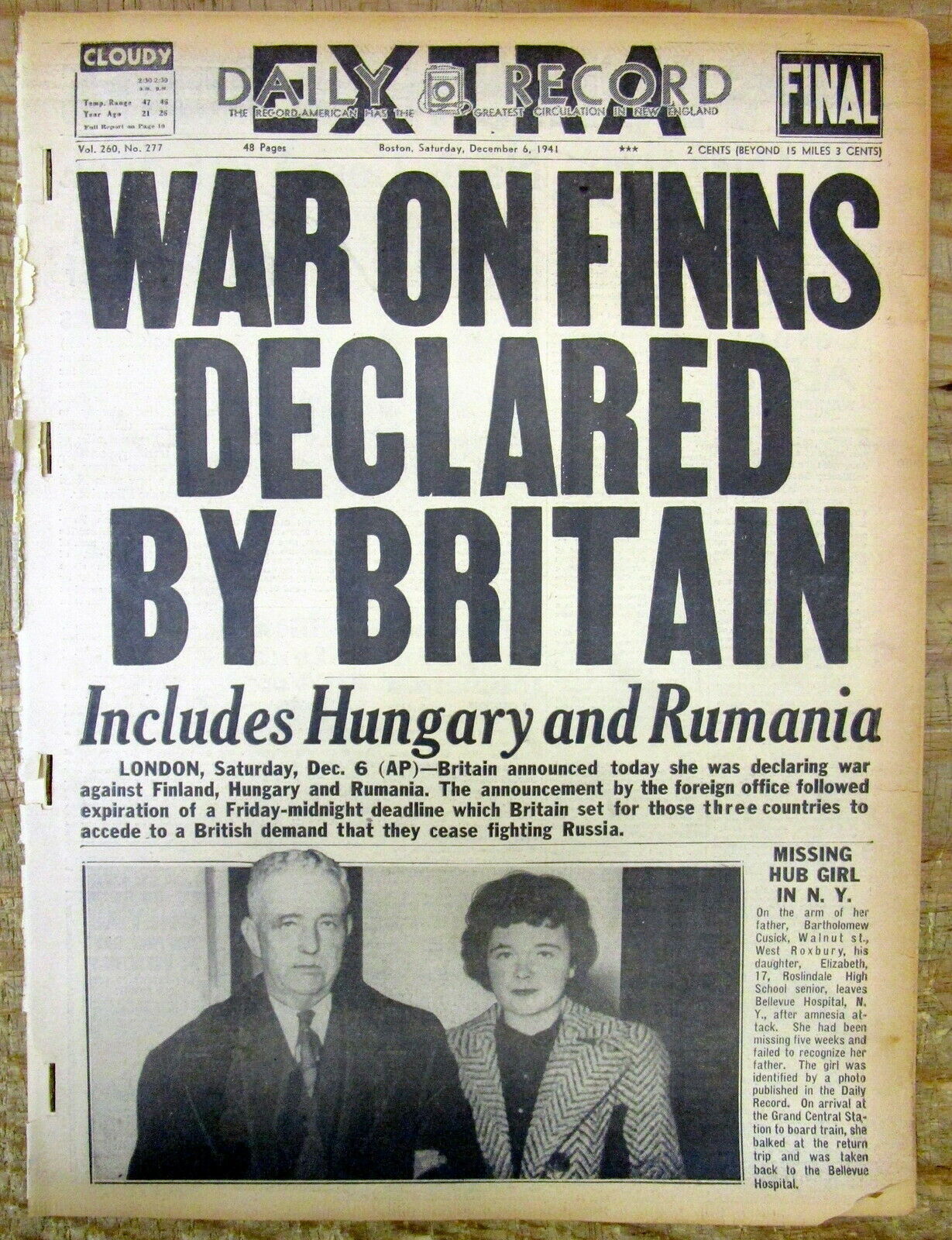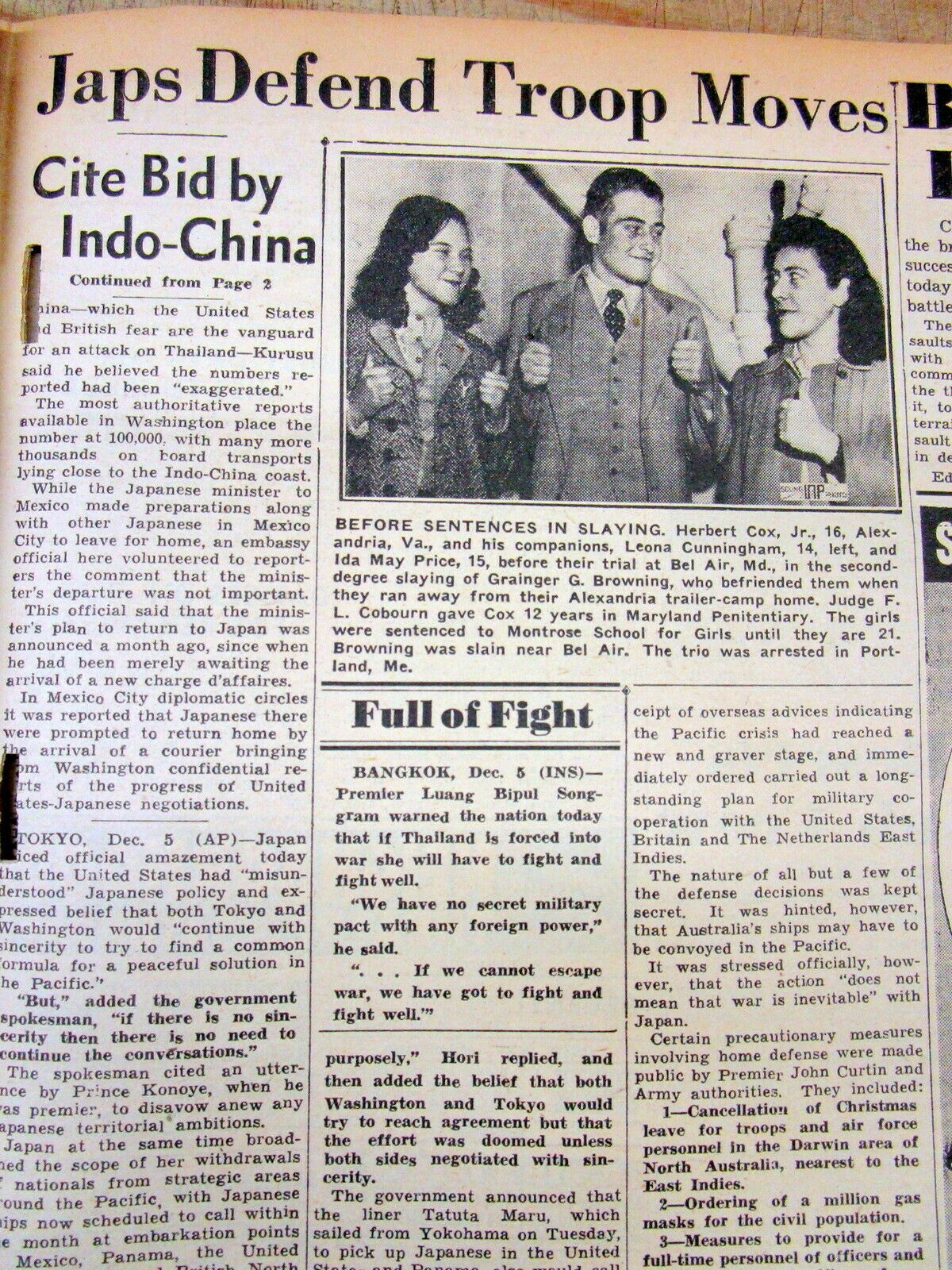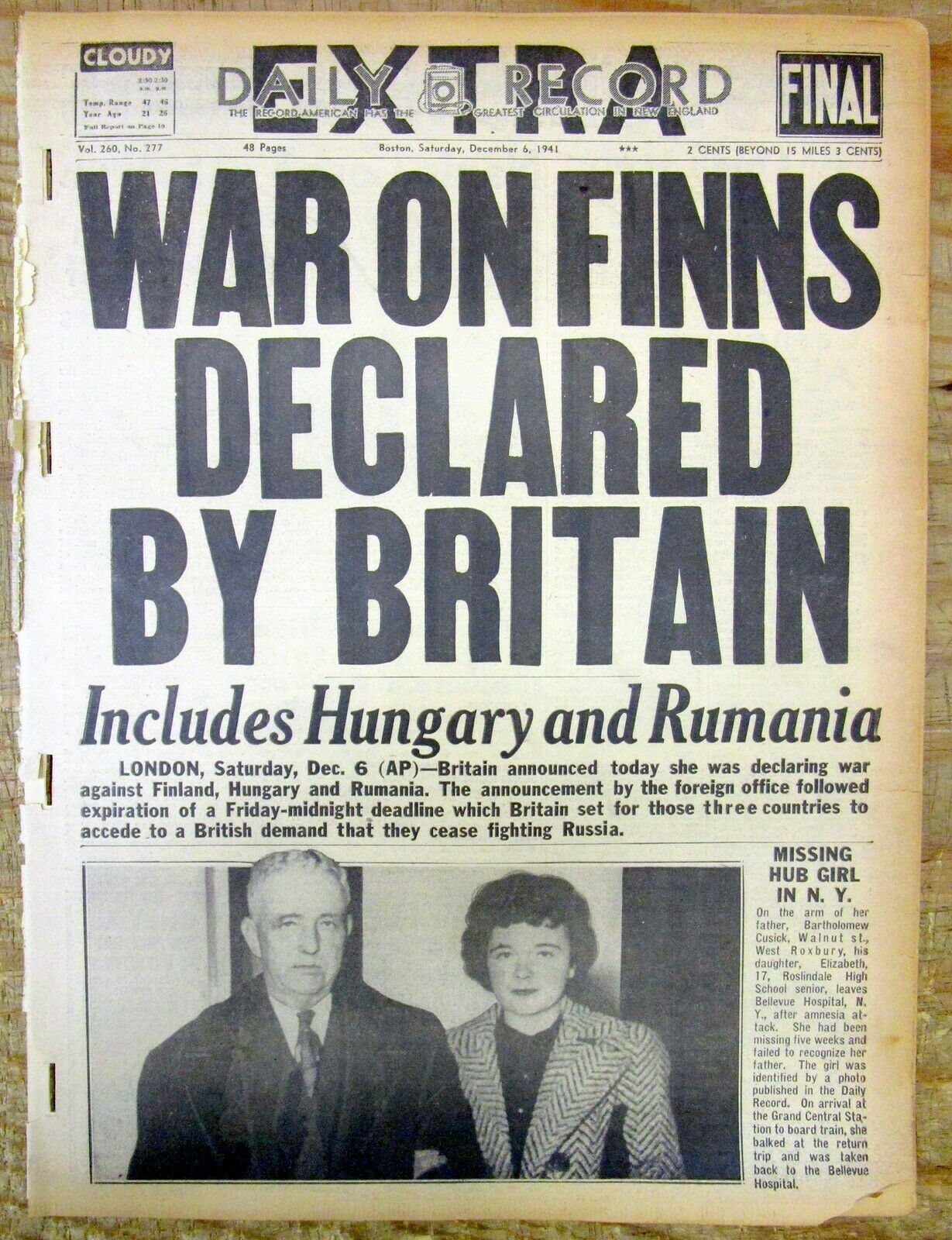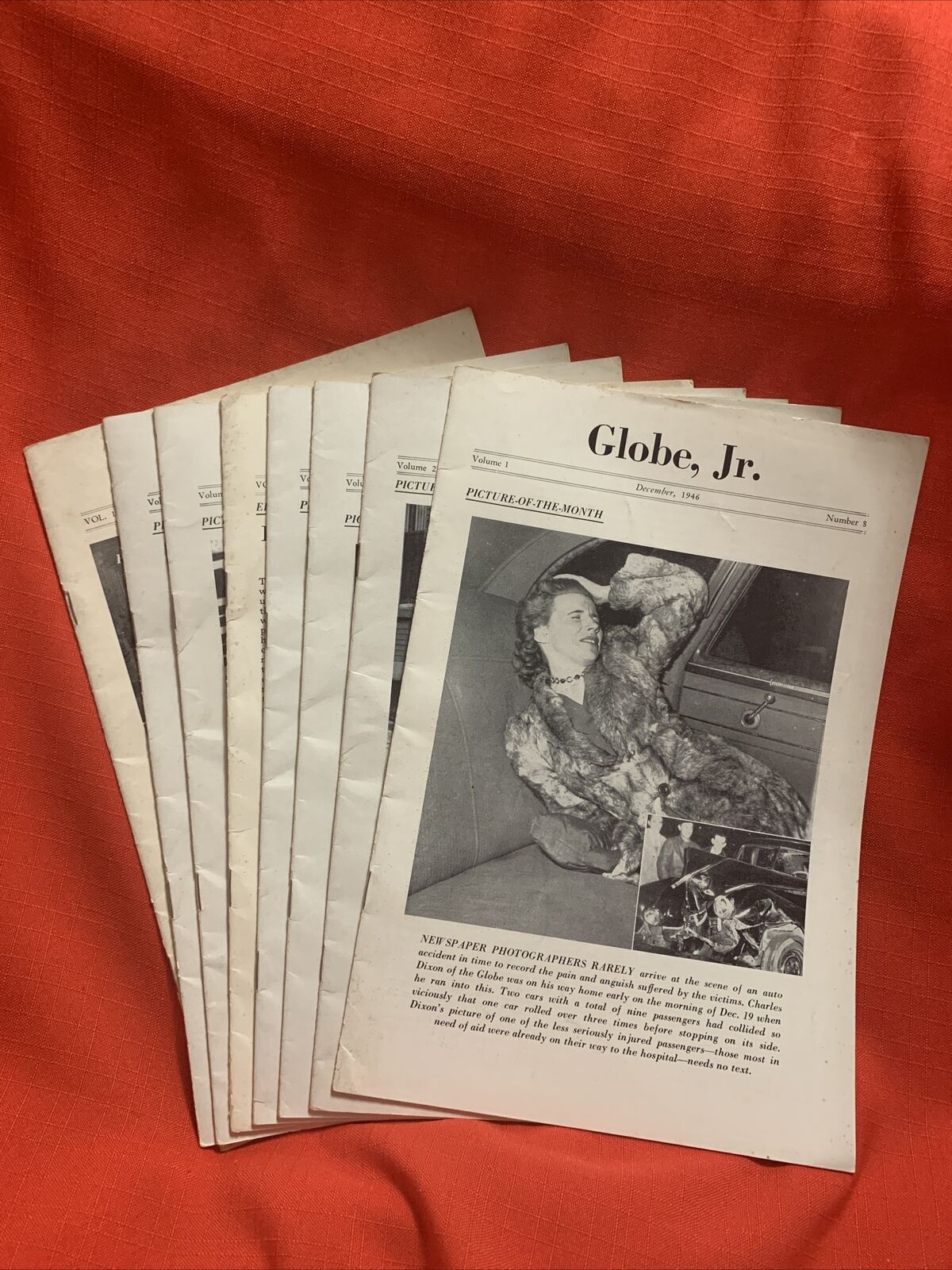-40%
12-6-1941 WW II newspaper JAPANESE TROOP MOVEMENTS dayBEFORE PEARL HARBOR attack
$ 21.12
- Description
- Size Guide
Description
12-6-1941 newspaper JAPAN Liesto the US
about its TROOP MOVEMENTS on the day before its sneak attack on the US Naval base at PEARL HARBOR Hawaii
-
inv # 4X-202
Please visit our EBAY STORE for THOUSANDS of HISTORICAL NEWSPAPERS on sale or at auction.
SEE PHOTO----- COMPLETE, ORIGINAL NEWSPAPER, the
Boston Daily Advertiser
(MA) dated December 6, 1941.
This newspaper contains a bold banner inside page headline and report of
JAPAN explaining (falsely) to US President Franklin D Roosevelt that the movements of Japanese troops in the far east were not threatening to the US
.
In spite of this reassurance by Japan, on the very next day (Dec 7, 1941) Japan attacked the US naval base at PEARL HARBOR, Honolulu, HAWAII and forced the US into WW II.
VERY INTERESTING "look back" at the DAY BEFORE the Japanese attack on the US Naval Base at Pearl Harbor, HI.
Preliminary planning for an attack on Pearl Harbor to protect the move into the "Southern Resource Area" (the Japanese term for the Dutch East Indies and Southeast Asia generally) had begun very early in 1941 under the auspices of Admiral Isoroku Yamamoto, then commanding Japan's Combined Fleet. He won assent to formal planning and training for an attack from the Imperial Japanese Navy General Staff only after much contention with Naval Headquarters, including a threat to resign his command. Full-scale planning was underway by early spring 1941, primarily by Rear Admiral Ry
ūnosuke Kusaka, with assistance from Captain Minoru Genda and Yamamoto's Deputy Chief of Staff, Captain Kameto Kuroshima. The planners studied the 1940 British air attack on the Italian fleet at Taranto intensively.
Over the next several months, pilots were trained, equipment was adapted, and intelligence was collected. Despite these preparations, Emperor Hirohito did not approve the attack plan until November 5, after the third of four Imperial Conferences called to consider the matter.
Final authorization was not given by the emperor until December 1, after a majority of Japanese leaders advised him the "Hull Note" would "destroy the fruits of the China incident, endanger Manchukuo and undermine Japanese control of Korea."
By late 1941, many observers believed that hostilities between the U.S. and Japan were imminent. A Gallup poll just before the attack on Pearl Harbor found that 52% of Americans expected war with Japan, 27% did not, and 21% had no opinion. While U.S. Pacific bases and facilities had been placed on alert on many occasions, U.S. officials doubted Pearl Harbor would be the first target; instead, they expected the Philippines would be attacked first. This presumption was due to the threat that the air bases throughout the country and the naval base at Manila posed to sea lanes, as well as to the shipment of supplies to Japan from territory to the south. They also incorrectly believed that Japan was not capable of mounting more than one major naval operation at a time.
On November 3, 1941, Nagano presented a complete plan for the attack on Pearl Harbor to Hirohito. At the Imperial Conference on November 5, Hirohito approved the plan for a war against the United States, Great Britain and the Netherlands, scheduled to start at the beginning of December if an acceptable diplomatic settlement were not achieved before then. Over the following weeks, Tōjō's military regime offered a final deal to the United States. They offered to leave only Indochina, but in return for large American economic aid. On November 26, the so-called Hull Memorandum
rejected the offer and demanded that, in addition to leaving Indochina, the Japanese must leave China (without Manchoukuo) and agree to an Open Door Policy in the Far East.
On November 30, 1941, Prince Takamatsu warned his brother, Hirohito, the navy felt the Empire could not fight more than two years against the United States and wished to avoid war. After consulting with Kōichi Kido (who advised him to take his time until he was convinced) and Tōjō, the Emperor called Shigetarō Shimada and Nagano, who reassured him that war would be successful. On December 1, Hirohito finally approved a "war against United States, Great Britain and Holland" during another Imperial Conference, to commence with a surprise attack on the U.S. Pacific Fleet at its main forward base at Pearl Harbor, Hawaii.
Very good condition. This listing includes the complete entire original newspaper, NOT just a clipping or a page of it. STEPHEN A. GOLDMAN HISTORICAL NEWSPAPERS stands behind all of the items that we sell with a no questions asked, money back guarantee. Every item we sell is an original newspaper printed on the date indicated at the beginning of its description. U.S. buyers pay priority mail postage which includes waterproof plastic and a heavy cardboard flat to protect your purchase from damage in the mail. International postage is quoted when we are informed as to where the package is to be sent. We do combine postage (to reduce postage costs) for multiple purchases sent in the same package.
We list thousands of rare newspapers with dates from 1570 through 2004 on Ebay each week. This is truly SIX CENTURIES OF HISTORY that YOU CAN OWN!
Stephen A. Goldman Historical Newspapers has been in the business of buying and selling historical newspapers for over 45 years. Dr. Goldman is a consultant to the Freedom Forum Newseum and a member of the American Antiquarian Society. You can buy with confidence from us, knowing that we stand behind all of our historical items with a 100% money back guarantee. Let our 45+ years of experience work for YOU ! We have hundreds of thousands of historical newspapers (and their very early precursors) for sale.













